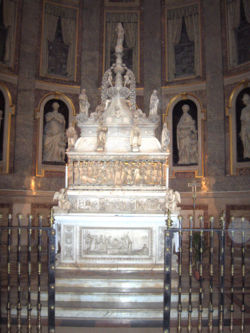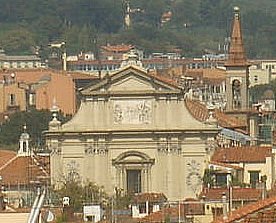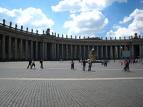U.S.A.
Shrine of St Jude
- Chicago, Il
Parts of St
Dominic's Tomb - Boston, MA
Italy
Santa Sabina
- Rome, Italy
Vatican
City - Rome, Italy
Basilica of San Domenico - Bologna,
Italy
Croatia
The
Dominican Monastery, Dubrovnik, Croatia
Austria
St. Maria
Rotunda's Church, Vienna, Austria
Dubrovnik - Dominican Monastery
 Passing
through the Street St. Dominic one can tour the large complex of the
Dominican monastery and church. Aside from numerous paintings by the
most important members of the Dubrovnik school of art from the 15th
and 16th centuries, and Veneziano's great "Crucifixion" and Tizian's
effigy of St. Magdalene and St. Blasius, in the Dominican church and
sacristy there are a number of sarcophagi and tombs of archbishops,
bishops and members of the nobility. The church walls are decorated
with additional masterpieces Virgin Mary and St. John by Lorenzo di
Marino Dobričević (15th C); two altarpieces by Francesco di Maria
(17th C); Miracle of St. Dominic by Vlaho Bukovac (a local 19th C
work in the Sicilian manner). Passing
through the Street St. Dominic one can tour the large complex of the
Dominican monastery and church. Aside from numerous paintings by the
most important members of the Dubrovnik school of art from the 15th
and 16th centuries, and Veneziano's great "Crucifixion" and Tizian's
effigy of St. Magdalene and St. Blasius, in the Dominican church and
sacristy there are a number of sarcophagi and tombs of archbishops,
bishops and members of the nobility. The church walls are decorated
with additional masterpieces Virgin Mary and St. John by Lorenzo di
Marino Dobričević (15th C); two altarpieces by Francesco di Maria
(17th C); Miracle of St. Dominic by Vlaho Bukovac (a local 19th C
work in the Sicilian manner).
 Union
City, New Jersey -
Dominican Nuns of the Perpetual Rosary Union
City, New Jersey -
Dominican Nuns of the Perpetual Rosary
Echoing the quiet, mostly residential area of 14th Street
in Tucked amid the brownstones that line the block are formidable
stone walls encasing a Gothic-style building, which is commonly
called the Blue Chapel and currently houses five cloistered
Dominican nuns who have taken on St. Dominic’s strict practice of
prayer.
 Santa
Sabina - Rome, Italy Santa
Sabina - Rome, Italy
The church and convent of Santa Sabina on the Aventine hill in
Rome have been home to the Order of Preachers (Dominicans) since the
13th century. In the center of the church there is a black stone
that, according to legend, was hurled at St. Dominic by the Devil.
It didn't harm him, of course, but it put a dent in the floor.
 Ark
of St Dominic -
Basilica of San
Domenico - Bologna, Italy Ark
of St Dominic -
Basilica of San
Domenico - Bologna, Italy
The Arca di San Domenico (Ark of Saint
Dominic) is a monument containing the remains of Saint Dominic. It
is located in Dominic’s Chapel in the Basilica of San Domenico in
Bologna, Italy. Saint Dominic died in the convent of the church of
San Nicolò delle Vigne on 6 August 1221. He was buried behind the
altar. The church of San Nicolò was expanded into the Basilica of
San Domenico between 1228 and 1240. The remains of the saint were
moved in 1233 from its place behind the altar into a simple marble
sarcophagus, situated on the floor in the right aisle of the church
for the faithful. Since most of the pilgrims, who came in great
numbers to see the grave, were not able to see this shrine, hidden
by so many people standing in front of it, the need was felt for a
new shrine.
In 1264 the Dominicans then
commissioned a new tomb for their founder to Nicola Pisano, the
famous sculptor of the pulpit of the Pisa Baptistery. He was
certainly responsible for the design of the new sarcophagus, but in
1265 he was already at work on another assignment, the pulpit for
the Siena Cathedral. The front side was done in his workshop,
partially by Nicola Pisano himself but mostly by his assistant Lapo
di Ricevuto. The rectangular sarcophagus was originally borne on
caryatid figures. When the Ark was later redesigned, these supports
were dispersed and are now tentatively identified in several
museums: the archangels "Michael" and "Gabriel" (in the Victoria and
Albert Museum, London), the statue "Faith" (Louvre, Paris), a group
of three deacons (in the Bargello, Florence) and a similar group in
the Museum of Fine Arts,
Boston, Massachusetts, USA.
 Dominican
Shrine of St. Jude Thaddeus Dominican
Shrine of St. Jude Thaddeus
Dominican Shrine of St. Jude Thaddeus
1909 South Ashland Avenue
Chicago, IL 60608-2994
Phone 312.226.0020
info@shrineofsaintjude.com
MUSEUM OF DOMINICAN St. CATHERINE`S MONASTERY
A visit to the oldest building preserved in the Old Town of
Tallinn is worthwhile.
One
of the best-kept secrets of Tallinn is to be found in the very
center of the city. Located near Viru Street, between Müürivahe and
Vene Streets, is a medieval Dominican monastery which reveals a
fascinating dimension of the city’s history.
The
Dominican Order was founded by a Spaniard, Saint Dominic Gusman, in
1216. Up to that moment only bishops were permitted to preach, but
their performance was inadequate beause of the time they had to
devote to the administrstion of their dioceses. The result was that
many Christians heard the Word of God rarely if at all . Dominic
envisioned the creation of a body of trained theologians who would
scatter throughout Europe and proclaim the gospel in the most remote
areas. The nordic countries appear very early on the Dominic
anagenda.
To
reach Tallinn the friars followed the trade route along the southern
coast of the Baltic Sea, and reached Estonia some 750 years
ago. The monastery in Tallinn was certainly in existence
by1246.Constructed in the gothic style, it exhibits a number of
Interesting architectural features,and contains the largest
collection of carved stones in Estonia.
The
site of the monastery in the Old City was carefully chosen in order
to facilitate both the ministry of the friars and their business
interests.They traded in fish in order to support themselves,but
their reason for existing was preaching the word of God. The seal of
the monastery bore the words ‘Order of Preachers”. The people,
however, knew it as “Blackfriars Monastery’ because of the black
cloak the friars wore in public over their white habit. Accoding to
medieval documents the monastery was dedicated to Saint Catherine. A
common symbol of the Dominican Order is a black and white dog
holding in his mouth a burning torch. It derives from a pun on the
Latin name of the friars, “Dominicanes”, which means ‘the followers
of Dominic”. But the name could be split into two words “Domini
canes” which means “the hounds of the Lord”. The torch represents
the flame of truth. The monastery was celebrated for its scholarship
Its best known prior was an Estonian from Tallinn named
Mauritius. He studied theology in Cologne with one of the most
eminent medieval scholars, Saint Albertus Magnus, and may have been
a fellow-student of St Thomas Aquinas. Mauritius completed his
studies at the University of Paris, which was then the best in
Europe. On his return to his native land Mauritius kept in touch
with colleagues in Germany. His intellectual stature is indicative
of the quality of the monastery’s leadership. The offerings made on
the occasion of such family festivals made a significant
contribution to the monastery’s finances. The various guilds gave
gifts when their feast days were celebrated. The Merchant Guild, for
example, each year in December gave the friars a tun of meat, a tun
of codfish, and a tun of peas. Rich burgers left legacies to the
monastery for the privilege of having a family tomb in the church,
But these did not suffice to sustain all those whom the monastery
housed. The friars, in consequence, becaipe farmers and
fish-mongers. In addition they ran a brewery, which produced four
different kinds of beer. In northern Europe beer occupied the place
enjoyed by wine in the south, and was a staple element of both the
monastic and secular diet. The monastery also drew profit from the
veneration of relics. Many documents mention twelve silver
reliquaries containing the heads of saints. Some reposed on the high
altar whereas others were enshrined on side altars. Each ‘head was
reputed to cure a different set of diseases.
In
1517 the Reformation started in German and very quickly spread into
the Baltic states. The loyalty of the friars to Rome made them
immediate victims. In 1523 a Lutheran mob burnt down the Franciscan
monastery in Kuramaa. The Dominican monastery in Tallinn was
destroyed on ,1524.
In
1954 the former garden, cloister and refectory of the
Dominican monastery were restored and opened to visitors. One of the
most beautiful and peacefri pleaces in Talliun is the cloister
garden whict is-bordered on one side by the church of Saints Peter
and Paul and on the other by the original church of Saint Catherin.
The .cloisxer and refectory contain a permanent exhibition of carved
stone slabs.
Sea
and limestone ( dolomaite) are two symbols of northern Estonia.
Tallinn owes much of its distincitve flavour to the use of the
beautiful stone in its walls and towers,and in its secular and
religious architecure. Carved stone decorated public buildings and
private houses. The designs employed belong to the Gothic
renaissance and Baroque periods. Windows were emphasized by slender
piers and graceful curves. Armorial sheilds bespoke the pride of
their owners.
The
monumental masons of Talliun were famous throughout northern Europe.
Their carvings were in demand in Finland and other countries. The
profession was highly organized. The masters constituted an
exclusive guild. Boys served a three-year apprenticeship during
which they were bound to a patricular master. If an apprentice ran
away no other master could employ him. The next stage was that of
journeyman. Its duration varied, but it came to an end when the
candidate produced a master-work a small door, or window pillar, or
circular wash-basin-which won the approval of 6-8 masters, Arent
Passer a master mason from the Netherlands, exercised great
influence on the local school of stone carving.
 Florence,
Italy - Museo di San Marco (Museum of Saint Marcus Florence,
Italy - Museo di San Marco (Museum of Saint Marcus
The museum of San Marco in Florence comprises a church and an old
Dominican monastery, restored and enlarged by Michelozzo under
orders from Cosimo I de Medici. During the 15th century the
monastery was home to two famous Dominicans, the painter Fra
Angelico and the preacher, Girolamo Savonarola. A famous collection
of manuscripts is housed in the monastery library built by
Michelozzo. Each cell of the monks’ cloister (and many other walls
of the halls and rooms) were decorated with frescoes by Fra Angelico
in collaboration with others, including Benozzo Gozzoli.

Dominican Saints on the Colonnade of Bernini
Rome, Italy, Vatican City
On 31 July 1656 the architect Giovanni Lorenzo Bernini received
the commission to build a colonnade around the piazza in front of
the basilica of Saint Peter. A colonnade was a brilliant solution to
the problem of providing a monumental entrance to the basilica.
After the completion of the facade of the new church, the square in
front was a sloping area irregularly surrounded by buildings.
Bernini developed different plans, but between April 1659 and
January 1660 he presented a wooden (scale-)model of his colonnade.
It is composed of four rows of columns which allow free passage in
and out, but act as visual barrier to the outside except when viewed
from two points in the square where the four rows of columns line
up.
On his colonnade Bernini put 133 statues of martyrs, confessors
and saints. He designed 96 statues of travertine, which were made by
many sculptors. Lazzaro Morelli took the lion's share. Between 1661
and 1668 he sculptured 18 statues. Among the statues also 6
Dominican Saints. Standing before the basilica
at the right: statue 6: Albertus Magnus; 20: Dominic; 70: Thomas
Aquinas.
At the left: statue 7: Ludovic Bertrandus; 21: Hyacinth of Poland;
24: Rose of Lima.
Church of Santa Maria Sopra Minerva
Preserves the majority of the remains of St. Catherine of Siena
beneath the main altar in a sarcophagus covered with a marble statue
of St. Catherine (Cruz 1984: 227).

St. Maria
Rotunda's Church - This Dominican Church is an
Early
Baroque church in the historic center of
Vienna, Austria. It is the third church built on
the same site in the course of time
The first church on this site was built in 1237 by
the newly arrived Dominicans on a piece of land
allotted in 1225-1226 by the duke
Leopold VI. The church was enlarged between
1240-1270 and a new choir was added in 1273. A
series of fires caused the construction of a new
Gothic church between 1283 and 1302. The nave was
extended netween 1458 and 1474. This church
consisted of a nave with five cross vaults, and two
aisles This church was heavily damaged during the
first siege of Vienna by the Turkish army in 1529.
The choir was demolished and the nave was partly
taken down. The building became more and more
dilapidated during the next period.
The new-found self-awareness of the
Counter-Reformation didn’t allow any more such a
sorry state for a church. In 1631 the Dominicans
started to build a new oblong church with a dome,
following the plan of
Jacopo Tencala, architect of Prince Maximilian
of Liechtenstein. The master builders were Jacopo
Spacio, Cipriano Biasino and
Antonio Canevale. They introduced to Vienna the
Baroque style of Italy. The church was elevated
to the status of basilica minor in 1927 under the
name “Rosary Basilica ad S. Mariam Rotundam
|